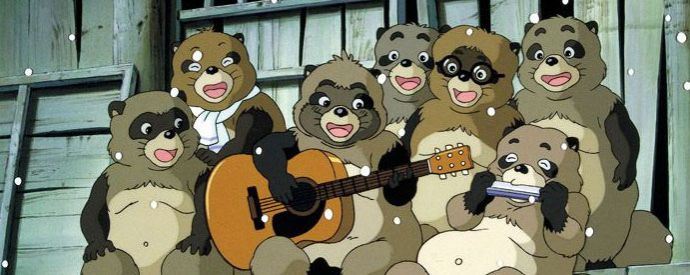Movies /
Animé and Toons
Pom Poko

By Hervé St-Louis
January 23, 2015 - 16:52
Pom Poko is about raccoons in a Tokyo suburb that attempt to stall and resist the conversion of their territory in to human housing. The raccoon rehearse their ancient transformation skills to trick the human workers adapting their territory. They act as ghosts and other creatures to discourage the construction. When that fails, the raccoons put on a bigger show of transformation but the cost to them may be too much to bear. Will they save their world from human encroachment?
Pom Poko is very fun to watch. It feels like watching a folk tale with a bunch of villagers who enjoy the good life. A lot of humour is made about the fact that raccoon are lazy and not as cunning as foxes, which can also change shape. How I felt about this story is how say Filipinos would describe themselves and their culture versus cold and mathematical Koreans. There was a lot of humanity in the various raccoon. What was funnier is that they could not sustain any plan for too long before thinking about food and other hedonist pleasures.
One problem that I had with this story is that there were so many different raccoons that I lost track of all the names and different plot intrigues that mattered to each set of raccoons. The story, of course, has a strong environmental message. This one is interesting because it’s not about endangered species and exotic animals we don’t encounter often. It’s about the common racoon that lives in many of our cities. I see racoons in my neighbourhood often. They are part of the landscape along with skunks, geese and squirrels. We don’t usually worry about them and even perceive them as pests. What Pom Poko does is to twist that assumption around and show how it is humans that are really the pests. For the record, raccoons are not a native specie in Japan. Humans introduced them.
The animation may not please everyone. It relies on gags and the raccoons often switch shapes from realistic to simplified forms to very cartoons versions of themselves. There are traditional animé idioms that often Western audiences do not understand or find annoying. Other Ghibli films tend to avoid such idioms and stick to realistic representations. Don’t discount the movie if you do not like these idioms. Kids will really appreciate them.
There are few extras within the set. Isao Takahata is an experienced animation director and some material about his career would have been cool bonuses.
Features
Original Japanese Storyboards, Original Japanese Trailer, Interview with Toshio Suzuki, Behind the Microphone
Rating: 9.5 /10
Last Updated: January 17, 2025 - 08:20

